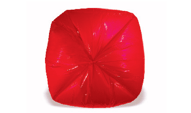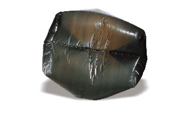
What Are the BAG Basics?
There are many different terms used when describing can liners. How can WAXIE help you pick the right bag for your receptacle?
| B = BAG SIZE |
| Start by determining the size of the receptacle. Measure the diameter and depth and then you can use WAXIE's Right-Size Guide to help you pick what you need! |
| A = APPLICATION |
| The type of trash and how it is transported determines the application of the bag. High Density bags are for smooth non-puncturing objects and easier transport conditions; and Linear and Low Density bags are for sharp rough objects and difficult transport conditions. |
| G = GAUGE |
| Some believe that if the trash bag is thicker, it will be stronger; which is not always the case. The performance of a bag involves several features, not just thickness. The gauge of a trash bag should be determined by now the bag is utilized. The correct gauge is needed to provide the correct performance. With thinner gauges there is less plastic used and therefore there is more cost savings. |

Can Liner Bottom Seals
Star Seals are the most preferable type of liner because they have the strongest seal. However, it is not possible to have a Star Seal with the thickest gauge of liner, so a Flat Seal is used. Gusset Seals are generally used for food service type bags and not for receptacles.
 Star Seals
Star Seals
- Most common type of seal
- Designed without gussets
- Conforms to the shape of the container
- Distributes weight evenly
- Maximizes carrying capacity
Gusset Seals
- Flat-style bag design
- Both sides tucked in to form gussets
- Sealed through four layers of film (the middle of the bag has
only two sealed layers)
Flat Seals

- Two-dimensional bag (much like a pillow case)
- Strong, but has the potential to leak wet trash from the corners
- Does not conform as well to the shape of can
Gauge Recommendations
Film thickness is not the only standard for judging bag strength. Advanced polymer blend formulations and unique additives produce thinner, lighter trash bags that are stronger than thicker bags made from inferior polymer blends. Below are basic gauge recommendations.
Mil (One thousandth of an inch) Term used in the measurement of LDPE and LLDPE can liners. One mil is .001 inch. Can liners range between .35 to 4.0 mil.
Mic Term used in the measurement of HMW-HD can liners. 25.4 microns equals .001 inch. 1,000 microns (M) = 1mm. HMW-HDPE can liners are 6 to 24 microns.
| HDPE Gauge (Mic) = Trash Weight |
6-9 |
10-12 |
12-13 |
15-17 |
- |
- |
18-20 |
21-22 |
| 15-25 lbs |
25-50 lbs |
51-60 lbs |
61-70 lbs |
- |
- |
71-80 lbs |
81-90 lbs |
| LLDPE† |
.30-.49 |
.50-.60 |
.61-.74 |
.75-.80 |
.81-1.00 |
1.2-1.2 |
1.3-1.9 |
2.0-3.0 |
| 10-20 lbs |
21-30 lbs |
31-40 lbs |
41-50 lbs |
51-60 lbs |
61-65 lbs |
66-70 lbs |
71-75 lbs |
| † Environmentally friendly Reprocessed Resin options available |
Density Types
LLDPE (Linear Low Density Polyethylene): Linear Low Density Bags are used for rough or sharp objects under tough transport conditions. These bags are very strong and are more resistant to tearing, but handle lower load capacities than HDPE bags. Best used for:
- Plastic eating utensils, food with rough edges
- Sticks, rough yard trimmings, or glass
- Metal w/sharp edges
HDPE (High Density Polyethylene): High Density Bags are used for paper and non-rough objects under moderate transport conditions. These bags are very strong and handle higher load capacities than LLDPE bags, but tear easier once punctured. Best used for:
- Cans without sharp edges, food without sharp edges
- Grass, rags, smooth heavy objects
- Paper-plates, cups, towels, office
Packages
Individually Folded: Can liners are separately folded, then stacked on top of one another. This allows the end-user to pull liners out of the box with much more ease vs. bulk-folded bags.
Cored Rolls: Can liners are rolled together on cardboard cylinders (looks similar to a roll of paper towels). Can liners come inside a special box that dispenses with ease.
Coreless Rolls: Can liners are rolled together without an internal core. This allows for thinner rolls and prevents excess waste. Rolls are perforated or are interleaved.






